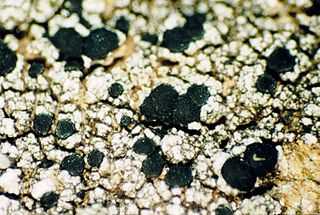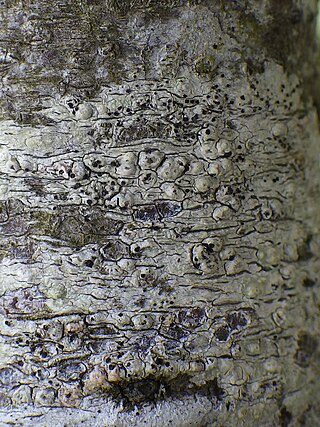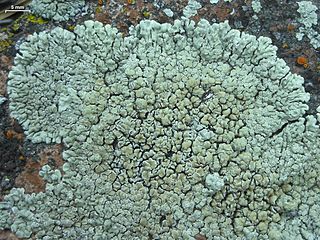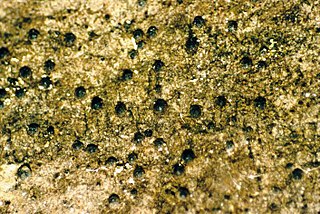
The Lecanoraceae are a family of lichenized fungi in the order Lecanorales. Species of this family have a widespread distribution.

The Ramalinaceae are a family of lichen-forming fungi in the order Lecanorales. First proposed by Carl Adolph Agardh in 1821, the family now comprises 63 genera and about 750 species. Ramalinaceae lichens exhibit diverse growth forms, including crustose, fruticose, squamulose, leprose, and byssoid thalli, and form symbiotic relationships primarily with green algae of the genus Trebouxia. The family is characterised by pale-coloured thalli, apothecia that are typically pale but may darken with age, and ascospores that vary in shape and septation.

Skyttea is a genus of lichenicolous (lichen-dwelling) fungi in the family Cordieritidaceae. The genus was circumscribed in 1981 by lichenologists Martha Allen Sherwood, David L. Hawksworth, and Brian J. Coppins, with Skyttea nitschkei assigned as the type species.

Mycobilimbia is a genus of lichen-forming fungi in the family Ramalinaceae.

Ropalospora is a genus of lichen-forming fungi, and the sole member of the monogeneric family Ropalosporaceae. The genus was circumscribed by Italian lichenologist Abramo Bartolommeo Massalongo in 1860. The family was proposed by Josef Hafellner in 1984.

Palicella is a genus of crustose lichens in the family Lecanoraceae. It contains six species.
Josef Hafellner is an Austrian mycologist and lichenologist. He was awarded the Acharius Medal in 2016 for his lifetime contributions to lichenology. Before his retirement, he was a professor at the Karl-Franzens-Universität in Graz. Hafellner started developing an interest in lichens while he was a student at this institution, studying under Josef Poelt. He earned a master's degree in 1975 and a PhD in 1978, defending a doctoral thesis about the genus Karschia. In 2003, Hafellner received his habilitation. By this time, he had studied with French lichenologist André Bellemère (1927–2014) at Saint-Cloud, where he learned techniques of transmission electron microscopy and how their application in studying asci could be used in lichen systematics. His 1984 work Studien in Richtung einer natürlicheren Gliederung der Sammelfamilien Lecanoraceae und Lecideaceae has been described as "probably the single most influential publication in lichen systematics in the latter half of the 20th century".

Protoparmeliopsis is a genus of saxicolous (rock-dwelling, crustose lichens in the family Lecanoraceae. It has about 20 species. The genus was circumscribed by French botanist Maurice Choisy in 1929.

Scoliciosporum is a genus of lichens in the family Scoliciosporaceae.
Eiglera is a small genus of crustose lichens belonging to the monotypic family Eigleraceae. Eiglera species are found in Europe and Northern America.
Sedelnikovaea is a genus of placodioid lichens in the family Lecanoraceae. The genus was circumscribed in 2015 by Sergey Kondratyuk, Min-Hye Jeong, and Jae-Seoun Hur to contain Sedelnikovaea baicalensis, the type species. Three additional species were transferred into the genus in 2019.
Placolecis is a genus of lichen-forming fungi in the family Catillariaceae. It has four species of saxicolous (rock-dwelling) and crustose lichens. The genus was circumscribed by Italian botanist Vittore Benedetto Antonio Trevisan de Saint-Léon in 1857. He did not assign a type species for the genus. Josef Hafellner designated a lectotype for Placolecis balanina in 1984, but subsequently, this taxon was folded into P. opaca.

Bryostigma is a genus of fungi of uncertain familial placement in the order Arthoniales. The genus is characterised by its thin, patchy growth that either partially embeds into its growing surface or forms an irregular, granular surface, with distinctive red or blue iodine staining of its hyphae and very small fruiting bodies. Most Bryostigma species are parasitic (lichenicolous), growing on other lichens, though a few species like B. lapidicola grow independently on stone or moss. While the genus was initially established with a single species growing on moss, it was significantly expanded in 2020 when several species were transferred from the related genus Arthonia based on DNA analysis, though this taxonomic reclassification has been subject to some scientific dispute. As of 2024, the genus includes seventeen species – thirteen parasitic and four independent lichen species.
Carbonea aggregantula is a species of lichenicolous (lichen-dwelling) fungus belonging to the family Lecanoraceae.

Verseghya is a genus of lichen-forming fungi in the family Pertusariaceae. It has two species. The genus was circumscribed in 2016 by lichenologists Sergey Kondratyuk, Laszlo Lőkös, and Jae-Seoun Hur, with Verseghya klarae assigned as the type species. This crustose species is found in South Korea, where it grows on the bark of a wide variety of both deciduous and coniferous trees. Molecular phylogenetic analysis showed that Verseghya klarae occupied a separate phylogenetic branch in the Pertusariaceae, situated between the genera Ochrolechia and Pertusaria and the Lecanora subcarnea species complex. Verseghya thysanophora was transferred to the genus in 2019. It is widely distributed in the Northern Hemisphere.

Verseghya thysanophora, commonly known as the mapledust lichen, is a species of mostly corticolous (bark-dwelling), leprose lichen in the family Pertusariaceae. This common species is widely distributed in the Northern Hemisphere. The thallus of the lichen is a thin patchy layer of granular soredia, pale green to yellowish green in colour. The main characteristics of the lichen include the presence of lichen products known as thysanophora unknowns, and the conspicuous white, fibrous prothallus that encircles the thallus.

Rhizoplaca novomexicana is a species of saxicolous (rock-dwelling), crustose lichen in the family Lecanoraceae. Found in North America, the lichen was first formally described as a new species in 1932 by Adolf Hugo Magnusson, as a member of the genus Lecanora. Sergey Kondratyuk proposed a transfer to the genus Protoparmeliopsis in 2012. Steven Leavitt, Xin Zhao, and H. Thorsten Lumbsch transferred it to the genus Rhizoplaca in 2015, when, following molecular phylogenetics analysis, they emended that genus to include three placodioid species previously placed in Lecanora.
Fauriea is a genus of lichen-forming fungi in the family Teloschistaceae. The genus, which contains seven species, is a member of the subfamily Caloplacoideae.

Glaucomaria is a genus of lichen-forming fungi in the family Lecanoraceae. It has seven species. The genus was circumscribed by Maurice Choisy in 1929. It contains crustose lichens formerly placed in the Lecanora rupicola species complex as defined by several previous authors.












